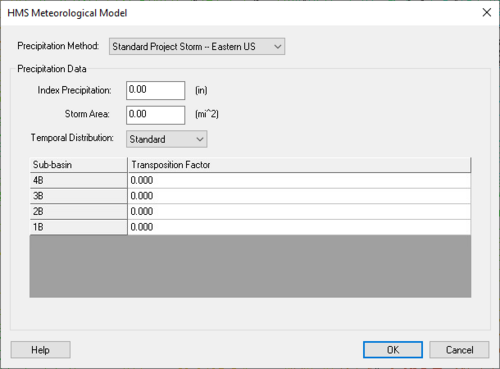WMS:HEC-HMS Meteorological Model
From XMS Wiki
Jump to navigationJump to search
Define meteorologic data for the model in the HMS Meteorologic Model dialog by selecting the Meteorologic Parameters menu item from the HEC-HMS menu. This dialog is used to assign precipitation data to all the basins in the model.
Users can choose from six precipitation methods or no precipitation.
User Hyetograph
This option can be used if a hyetograph is known for each sub-basin of the watershed being modeled.
- Precipitation Data
- Sub-Basin – Lists all subbasins in model.
- Hyetograph – Click the button to define.
- XY Series... – Opens the XY Series Editor
- Total Depth (in) – Input decimal number.
- Precip From Web – To download data from web, click the Download button.
- Download – Opens the Get Online NOAA Atlas 14 Data dialog.
User Gage Weighting
The User Gage Weighting method allows defining one or more gages for each sub-basin in the watershed model.
- Radar Data->Rain Gages – Click to open Convert Grids dialog.
- Precipitation Data –
- Sub-basin – Lists all subbasins in model.
- Total Storm Gages –
- Define... – Opens HEC Gage Weights dialog.
- Recording Gages –
- Define... – Opens HEC Gage Weights dialog.
- Index Precipitation (in) –
Frequency Storm
- Precipitation Data –
- Exceedance Probability – Drop-down selection of percentages up to 50%. Exceedance probability = (1 / Return Period) * 100%.
- Series Type – Select type from drop-down menu.
- Annual –
- Partial Duration –
- Max Intensity Duration – Select duration of intensity from drop-down menu. Choices range from 5 minutes to 6 hours.
- Storm Duration – Select length of storm. Choices range from 1 hour to 10 days.
- Peak Center – Percentages. 25-75%
- Storm Area – Area covered by storm. Decimal number in mi2.
- 5 min duration precip depth – Depth in inches.
- 15 min duration precip depth – Depth in inches.
- 1 hour duration precip depth – Depth in inches.
- 2 hour duration precip depth – Depth in inches.
- 3 hour duration precip depth – Depth in inches.
- 6 hour duration precip depth – Depth in inches.
- 12 hour duration precip depth – Depth in inches.
- 24 hour duration precip depth – Depth in inches.
- 2 day duration precip depth – Depth in inches.
- 4 day duration precip depth – Depth in inches.
- 7 day duration precip depth – Depth in inches.
- 10 day duration precip depth – Depth in inches.
Standard Project Storm - Eastern US
- Precipitation Data – Method selected for precipitation simulation.
- Index Precipitation: – Probably maximum index precipitation. Represents the total precipitation depth of the storm. Values available from HYDROMET Report 33. It can also be estimated from plates contained in EM 1110-2-1411 (US Army Corps of Engineers)
- Storm Area: – The total drainage area at the point where the standard project flood is to be estimated.
- Temporal Distribution: – Drop-down choices
- Standard – Distributes the precipitation according to the criteria outlined in EM 1110-2-1411.
- SWD – Distributes precipitation according to the Southwestern Division criteria (table 3.1 of the HEC-1 reference manual).
- Subbasin – Column containing all subbasins included in model.
- Transposition Factor – Can range from 0.80 to 1.40 and is multiplied by the index precipitation to determine the mean areal precipitation. The transposition factor can be determined from the SPS isohyetal pattern contained in EM 1110-2-1411 and a map of the watershed.
SCS Hypothetical Storm
This uses the four synthetic rainfall distributions developed by the Natural Resources Conservation Service (NRCS) from observed precipitation events.
- Precipitation Data –
- Storm Selection: – Drop-down menu of choices.
- Type I – Average of rainfall patterns associated with the Pacific climate - generally wet winters and dry summers
- Type Ia – Average of rainfall patterns associated with the Pacific climate - generally wet winters and dry summers
- Type II – Average of rainfall patterns associated with the majority of the United States
- Type III – Average of rainfall patterns associated with areas bordering the Gulf of Mexico and the Atlantic seaboard.
- Storm Depth – Decimal number in inches
- Storm Selection: – Drop-down menu of choices.
No Precipitation
Select this option if no precipitation will be in the model.
Gridded Precipitation
- Precipitation Data –
- DSS file: – Type file name or use Browse button to import file.
- Convert ASCII or XMRG files to DSS... – Opens Convert Grids dialog.
- Paths in DSS file: –
- Replace missing data with zero? –
- Yes – Toggle on if using this option.
- Time shift in hours (UTC-local time) – Type or use arrow buttons to change time shift.
Related Topics:
- Gages
- Convert Grids (NEXRAD Radar rainfall grids)
- Meteorological Options
- HMS Overview
- WMS:HEC-HMS Defining the Meteorological Model
WMS – Watershed Modeling System | ||
|---|---|---|
| Modules: | Terrain Data • Drainage • Map • Hydrologic Modeling • River • GIS • 2D Grid • 2D Scatter |  |
| Models: | CE-QUAL-W2 • GSSHA • HEC-1 • HEC-HMS • HEC-RAS • HSPF • MODRAT • NSS • OC Hydrograph • OC Rational • Rational • River Tools • Storm Drain • SMPDBK • SWMM • TR-20 • TR-55 | |
| Toolbars: | Modules • Macros • Units • Digitize • Static Tools • Dynamic Tools • Drawing • Get Data Tools | |
| Aquaveo | ||
